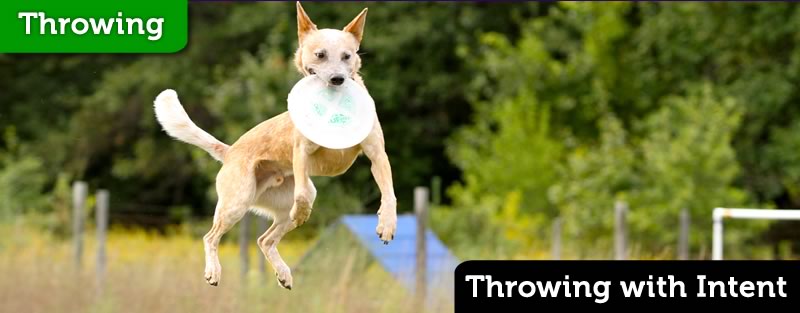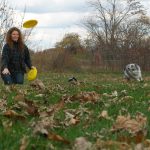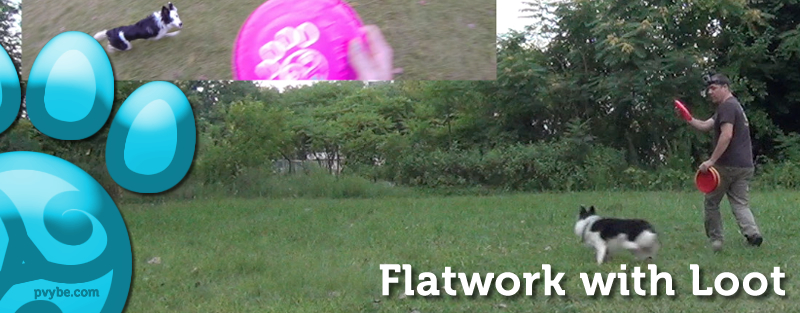
Disc Dog Flatwork Session with Loot
Clock and Counter Clock Flank
Any place out to your left or right side, further than Heel or Side position, that area is your Flank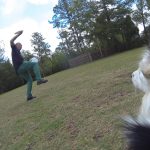 Out to the side of the handler is the Flank. If the dog is out to the handler's right or left the dog is on Flank. If the dog is moving with the... More. When your dog is out there to your side a ways and you are working and moving together, that is what we call Working the Flank. It means you and your dog are hooked up and are performing team movement. There is no individual pursuit, it’s not just a dog chasing the frisbee, or the dog running to a spot
Out to the side of the handler is the Flank. If the dog is out to the handler's right or left the dog is on Flank. If the dog is moving with the... More. When your dog is out there to your side a ways and you are working and moving together, that is what we call Working the Flank. It means you and your dog are hooked up and are performing team movement. There is no individual pursuit, it’s not just a dog chasing the frisbee, or the dog running to a spot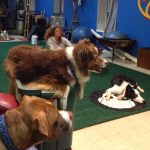 Spot is a “go to a place”, or “go to a mat” behavior. This means that the dog seeks out and performs a duration behavior on a spot of the handler’s choosing. A... More that the catch is supposed to happen, when you’re Working the Flank, you become a team, actively working and moving together.
Spot is a “go to a place”, or “go to a mat” behavior. This means that the dog seeks out and performs a duration behavior on a spot of the handler’s choosing. A... More that the catch is supposed to happen, when you’re Working the Flank, you become a team, actively working and moving together.
Loot is working in both the clockwise and counter clockwise direction. He’s often out to my left or right side moving with me. Throws happen and then we come back to this Flank position to get set up for the next trick or throw. Front Front is a stable position directly in front of the handler. Front is an traditional obedience skill. Usually your dog sits in this position, but standing is often acceptable as well, especially in... More position starts to happen less frequently. Set ups start to happen on the move from various angles. This is the essence of flatwork, and it often gets passed up in the pursuit of some crossing skill or flatwork gimmick.
Front is a stable position directly in front of the handler. Front is an traditional obedience skill. Usually your dog sits in this position, but standing is often acceptable as well, especially in... More position starts to happen less frequently. Set ups start to happen on the move from various angles. This is the essence of flatwork, and it often gets passed up in the pursuit of some crossing skill or flatwork gimmick.
The ability to confidently and competently move in both clockwise and counter clockwise directions should be a base level skill. You should know what your dog’s strong direction is and then take measures to leverage that to your advantage. Garnish with the weaker direction, or use both directions interchangeably to highlight your dog’s balance.
Front Cross as Speed Bump
The Front Crosses (Here!) in this session were cued pretty late and therefore wound up being pretty aggressive. Ideally they are not supposed to be so crowded and tight on the handler. This was somewhat intentional, as we were talking about using a late Front Cross to force a dog to slam on the brakes and shift direction.
I do like the spin Spins and Twists are tricks where the dog spins 360 degrees in a clockwise or counter clockwise fashion. Spin is clockwise and Twist is counter clockwise so it is important to have a... More move action on a few of the Front crosses Loot and I did. It’s not an application I have really explored, and I think they look rather nifty and could be a big part of generalizing the Front Cross
Spins and Twists are tricks where the dog spins 360 degrees in a clockwise or counter clockwise fashion. Spin is clockwise and Twist is counter clockwise so it is important to have a... More move action on a few of the Front crosses Loot and I did. It’s not an application I have really explored, and I think they look rather nifty and could be a big part of generalizing the Front Cross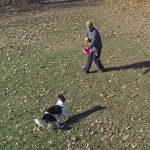 On a Front Cross, your dog switches Flanks in with you in front of them. From Clock to Counter Clockwise Flank or vice versa. Taken directly from the canine agility world, the Front... More concept and creating fresh and interesting sequences.
On a Front Cross, your dog switches Flanks in with you in front of them. From Clock to Counter Clockwise Flank or vice versa. Taken directly from the canine agility world, the Front... More concept and creating fresh and interesting sequences.
Rear Cross Repetition & Instant Replay
I just love the Repeating Rear Cross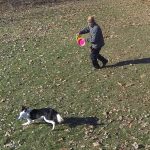 On a Rear Cross, the dog switches Flanks with the behind her. From clock to counter clockwise Flank or vice versa. Taken directly from the canine agility world, the Rear Cross is a... More pattern. It’s so nice, like a puppet master or a video game- everything happens right in front of your eyes, you really get to see it all, right there, and control the flow of the performance. And you get pretty much guaranteed performance.
On a Rear Cross, the dog switches Flanks with the behind her. From clock to counter clockwise Flank or vice versa. Taken directly from the canine agility world, the Rear Cross is a... More pattern. It’s so nice, like a puppet master or a video game- everything happens right in front of your eyes, you really get to see it all, right there, and control the flow of the performance. And you get pretty much guaranteed performance.
The Rear Cross (Squib!) creates a position that you, as a handler can rely on to be consistent. The dog will be oriented in the same manner with a predictable amount of speed while the Rear Cross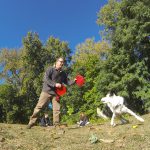 A Cross is an canine agility term that describes a change of working sides. Your dog moves from your left to your right (Heel to Side) or from Clock to Counter. Crosses are... More is being performed. This allows you to set up a perfect 2-3 stride toss to your dog with the interception in mind. It’s like instant replay.
A Cross is an canine agility term that describes a change of working sides. Your dog moves from your left to your right (Heel to Side) or from Clock to Counter. Crosses are... More is being performed. This allows you to set up a perfect 2-3 stride toss to your dog with the interception in mind. It’s like instant replay.
Rear Crosses are starting to take over from the Zig Zag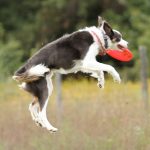 A Zig Zag is a series of catches in smooth succession that forces the dog to move back and forth across the field. Usually performed at a distance of 8-20 yards, the Zig... More pattern as the basis for our leaping drills because they are a little more fluid, making it easier to control and reduce speed and manage drive.
A Zig Zag is a series of catches in smooth succession that forces the dog to move back and forth across the field. Usually performed at a distance of 8-20 yards, the Zig... More pattern as the basis for our leaping drills because they are a little more fluid, making it easier to control and reduce speed and manage drive.
Balance
Loot is pretty well balanced, and seems to move easily in both the clockwise and counter clockwise fashion. Not all dogs are so balanced. Some are very unbalanced, finding it very difficult to move in one direction or the other. It is important for disc dog handlers to be aware of this so they can have appropriate expectations and more knowledge to apply to their training.
There is a bias towards the left and right hands of the handler that are important to keep in mind as well. Loot is dominant to the counter clockwise direction, but has a very hard time leaving the right hand and buying into the left handed disc lure/flourish that is the finish of the counter clockwise squib. Loot, it seems has more interest in keeping his eye on the target than switching back to his dominant side, an expected characteristic of a well balanced dog.
Punishing with a Pause
A couple of times in this session Loot took the wrong cue. Whether or not it was my faulty cue or Loot going on autopilot is up for debate, but it’s a moot point when it comes to dog training, the cue was given and it was not taken. Bummer… Game stops.
A short, consequent pause is a great form of negative punishment. If you have done a good job of creating a desire to play the game a Pause is a powerful tool.
Of course Pauses can, and frequently do impact our dog’s understanding of the game. I broke my first dog because of Pauses, Profanity & Pouting, and those Ps are just the start of a long list of potentially demotivating dog training. Be aware of and sensitive to the nature of pauses in your dog training. They are a big part of communication between you and your dog.
Be wary and mindful of pauses in your game and leverage them to your advantage as both a trainer and handler.
Flatwork Fatigue
Flatwork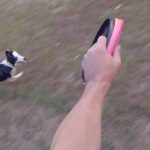 Flatwork is the stuff that happens between the catches. How the team moves and transitions, often without the disc, is flatwork. Flatwork concepts in disc dog are taken from the agility and herding... More is a lot of running. 5 minutes of sprinting at 20+MPH is almost 2 miles... of sprinting, leaping and turning! It’s a ton of work for a dog. Don’t over do it. Nothing is worse than turning the game of our dreams into some kind of cardio torture nightmare. This is especially true of dogs with lower to medium drive.
Flatwork is the stuff that happens between the catches. How the team moves and transitions, often without the disc, is flatwork. Flatwork concepts in disc dog are taken from the agility and herding... More is a lot of running. 5 minutes of sprinting at 20+MPH is almost 2 miles... of sprinting, leaping and turning! It’s a ton of work for a dog. Don’t over do it. Nothing is worse than turning the game of our dreams into some kind of cardio torture nightmare. This is especially true of dogs with lower to medium drive.
Short, exciting flatwork sessions with dismissal early and often is a good mantra for disc dog flatwork training. BTW… The thinking and moving at the same time make it an excellent exercise for high drive dogs who could use some help with their off switches, if you know what I mean…
Don’t get caught up as a handler if you can’t do a Front or Rear cross or can’t wrap your head around the concept or physical performance of the skill. It’s not that big a deal. Stick the the basics of flatwork – Setting the Flank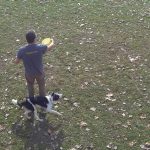 Setting the Flank means to throw out to your right or left. It’s really simple, just face any direction, send the dog Around, and then turn and throw the disc out to the... More, Directional FeedingDirectional Feeding is the underlying essence of disc dog freestyle. As a concept, it consists of reading the dog’s line and delivering a well placed disc that elicits a leap where she is... More, Zig Zag, and Around the World
Setting the Flank means to throw out to your right or left. It’s really simple, just face any direction, send the dog Around, and then turn and throw the disc out to the... More, Directional FeedingDirectional Feeding is the underlying essence of disc dog freestyle. As a concept, it consists of reading the dog’s line and delivering a well placed disc that elicits a leap where she is... More, Zig Zag, and Around the World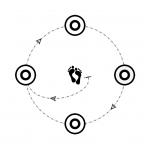 An Around the World is a disc dog flatwork pattern consisting of 4 catches in a circular pattern around the handler. This pattern is typically larger than 5 yards and often features creative... More patterns – and get on with other parts of the game.
An Around the World is a disc dog flatwork pattern consisting of 4 catches in a circular pattern around the handler. This pattern is typically larger than 5 yards and often features creative... More patterns – and get on with other parts of the game.
If you never throw the disc, the dog never leaves your side. This is an important aspect to flatwork fatigue. Throughout this session, as I went further and further with my criteria for the flatwork and my performance of the skills, Loot got closer and closer to me. This happens to me all the time if I’m not thoughtful about reward placement or if, “Just one more try…” kicks in and I run the session too long. So throw your discs early and often to get your dog and keep your dog at a good working distance, and make sure you don’t push too long and hard.







